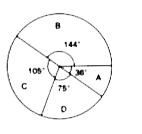In a class of 45 pupils ,21 play chess , 23 play cards and 5 play both the games . Find
how many do not play any of the games,
The correct Answer is:6
To solve the problem step by step, we will use the principle of inclusion-exclusion.
Step 1: Identify the total number of pupils and those who play games
- Total number of pupils = 45
- Number of pupils who play chess = 21
- Number of pupils who play cards = 23
- Number of pupils who play both chess and cards = 5
Step 2: Calculate the number of pupils who play at least one game
To find the total number of pupils who play at least one game, we can use the formula:
Number of pupils who play at least one game=(Number who play chess)+(Number who play cards)−(Number who play both)
Substituting the values:
Number of pupils who play at least one game=21+23−5
Step 3: Perform the calculation
Now let's calculate:
21+23=44
Then subtract the number of pupils who play both:
44−5=39
So, 39 pupils play at least one game.
Step 4: Calculate the number of pupils who do not play any games
To find the number of pupils who do not play any games, we subtract the number of pupils who play at least one game from the total number of pupils:
Number of pupils who do not play any games=Total pupils−Number who play at least one game
Substituting the values:
Number of pupils who do not play any games=45−39
Step 5: Perform the final calculation
Now let's calculate:
45−39=6
Thus, the number of pupils who do not play any games is 6.
Final Answer
The number of pupils who do not play any of the games is 6.
---
- Total number of pupils = 45
- Number of pupils who play chess = 21
- Number of pupils who play cards = 23
- Number of pupils who play both chess and cards = 5
To find the total number of pupils who play at least one game, we can use the formula:
Number of pupils who play at least one game=(Number who play chess)+(Number who play cards)−(Number who play both)
Substituting the values:
Number of pupils who play at least one game=21+23−5
Now let's calculate:
21+23=44
Then subtract the number of pupils who play both:
44−5=39
So, 39 pupils play at least one game.
To find the number of pupils who do not play any games, we subtract the number of pupils who play at least one game from the total number of pupils:
Number of pupils who do not play any games=Total pupils−Number who play at least one game
Substituting the values:
Number of pupils who do not play any games=45−39
Now let's calculate:
45−39=6
Thus, the number of pupils who do not play any games is 6.
The number of pupils who do not play any of the games is 6.
Topper's Solved these Questions
Similar Questions
Knowledge Check
In a class of 80 students, 39 students play football and 45 students play cricket and 15 students play both the games. Then the number of students who play neither is
A(a) 11B(b) 14C(c) 16D(d) 18
In a class of 45 students each one plays either Cricket or Hockey. If 30 play Cricket and 27 play Hockey then :
how many play Hockey only ?
View SolutionIn a class of 45 students each one plays either Cricket or Hockey. If 30 play Cricket and 27 play Hockey then :
how many play both Cricket and Hockey ?
View SolutionIn a class of 45 students each one plays either Cricket or Hockey. If 30 play Cricket and 27 play Hockey then :
how many play Cricket only ?
View SolutionIn a class of 40 students, 24 like to play guitar and 25 like to play piano. If each students like at least one of the musical instrutment, then how many like to play both piano and guitar?
View SolutionOut of 800 boys in a school, 224 played cricket, 240 played hockey and 336 played basketball. Of the total, 64 played both basketball and hockey; 80 played cricket and basketball and 40 played cricket and hockey; 24 played all the three games. The number of boys who did not play any game is
View SolutionOut of 800 boys in a school, 224 played cricket, 240 played hockey and 336 played basketball. Of the total, 64 played both basketball and hockey ; 80 played cricket and basketball and 40 played cricket and hockey 24 player all the three games. The number of boys who did not play any game is
View SolutionThe adjoining diagram shows a pie-chart with central angles for number of players playing four games A, B, C and D. If each player takes part in only one game and there are 480 players in all, find :
(i) how many players play the game D?
(ii) how many players do not play game B?
(iii) what is the ratio of players playing game A to the players playing game C ?
(iv) what percentage of players are playing game B?

View Solution
